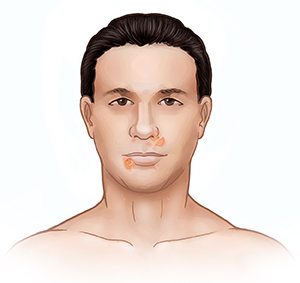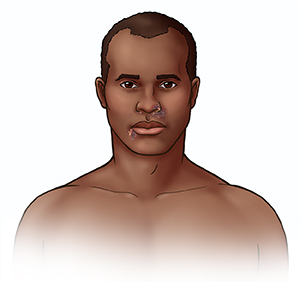Understanding Impetigo
Impetigo is a common bacterial infection of the skin. It most often affects the face, arms, and legs. But it can appear on any part of the body. Anyone can have it, regardless of age. But it's most common in children. Impetigo is very contagious. This means it spreads easily to other people.
 |
| Impetigo on light skin. |
 |
| Impetigo on dark skin. |
How to say it
ihm-peh-TI-goh
What causes impetigo?
Many types of bacteria live on normal, healthy skin. The bacteria usually don’t cause problems. Impetigo happens when bacteria enter the skin through a scratch, break, sore, bite, or irritated spot. They then begin to grow out of control, leading to infection. The 2 most common bacteria causing impetigo are Staphylococcus and Streptococcus. In some cases, impetigo appears on skin that has no visible break. It may be more likely to occur on skin that has another skin problem, such as eczema. It may also be more common after a cold or other virus.
Symptoms of impetigo
Symptoms of this problem include:
-
Small, fluid-filled blisters on the skin that may itch, ooze, or crust
-
A yellow, honey-colored crust on the infected skin
-
Skin sores that spread with scratching
-
An itchy rash that spreads with scratching
-
Swollen lymph nodes
Treatment for impetigo
The goal is to treat the infection and prevent it from spreading to others.
-
You'll likely be given an antibiotic to treat the infection. This may be a cream or ointment to put on your skin. You usually need to use the cream or ointment for about 5 days. If the infection is severe or spreading, you may be given antibiotic medicine to take by mouth. Be sure to use this medicine as directed. Don't stop using it until you're told to stop, even if your skin gets better. If you stop too soon, the infection may come back and be harder to treat.
-
Try not to scratch or pick at your sores. It may help to cover affected areas with a bandage.
-
To prevent spreading the infection, wash your hands with soap and clean, running water for at least 20 seconds before and after touching your skin. . Wash your hands frequently during the day.
-
Don't share personal items, towels, clothes, pillows, and sheets with others. After each use, wash these items in hot water.
-
Clean the affected skin several times a day. Don’t scrub. Instead, soak the area in warm, soapy water. This will help remove the crust that forms. For places that you can't soak, such as the face, place a clean, warm (not hot) washcloth on the affected area. Use a new washcloth and towel each time.
When to call your healthcare provider
Call your healthcare provider right away if you have any of these:
-
Fever of 100.4°F (38°C) or higher, or as advised by your provider
-
More sores or more spreading areas of redness after 2 days of treatment with antibiotics
-
More swelling or pain
-
More fluid or pus coming from the sores
-
Abnormal drowsiness, weakness, or change in behavior
-
Loss of appetite or vomiting
Online Medical Reviewer:
Marianne Fraser MSN RN
Online Medical Reviewer:
Michael Lehrer MD
Online Medical Reviewer:
Raymond Kent Turley BSN MSN RN
Date Last Reviewed:
5/1/2022
© 2000-2025 The StayWell Company, LLC. All rights reserved. This information is not intended as a substitute for professional medical care. Always follow your healthcare professional's instructions.